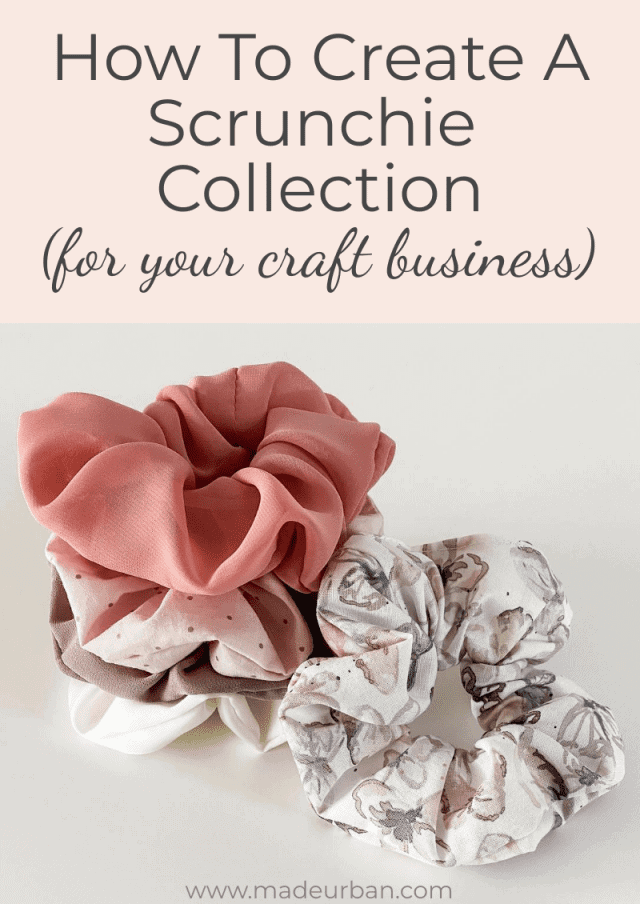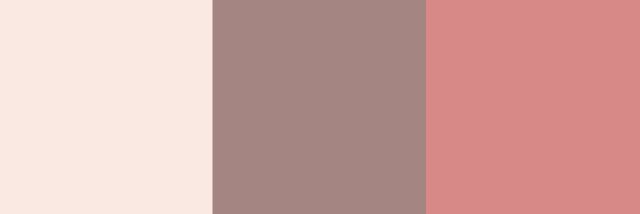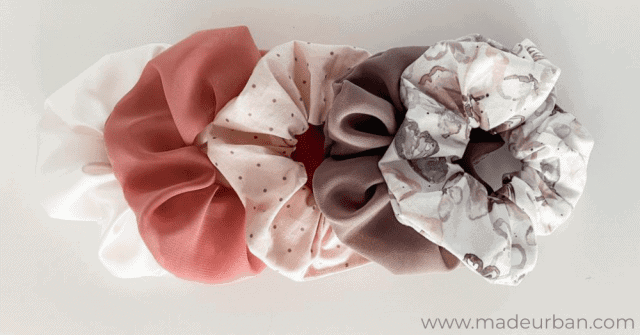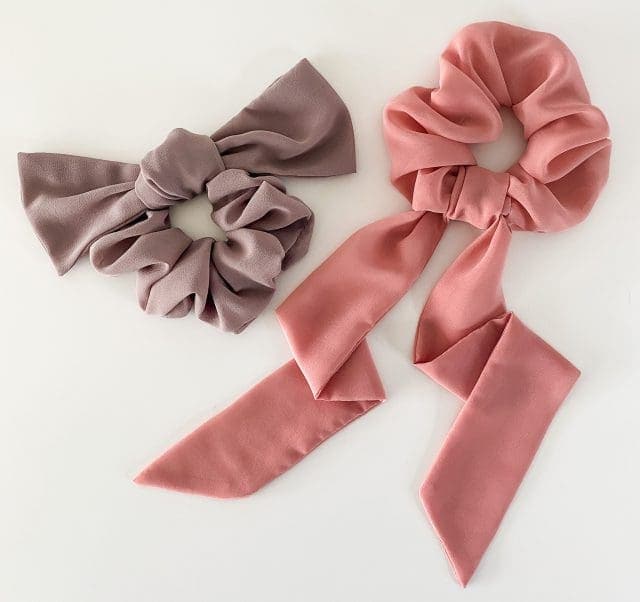How to Create a Scrunchie Collection
Although you can create a wide range of scrunchie options and make sales, creating scrunchie collections will:
- Boost sales
- Increase the perceived value of your scrunchies
- Increase your units per transaction
- Streamline your production and increase your profits
- Make your business appear more professional and potentially attract wholesale orders
Collections will help tell a story, evoke a feeling in consumers, and help them visualize when and where they might wear your scrunchies.
This article will explain the exact steps you can take to build product collections for the scrunchies you sell.

Important Note
One of the biggest mistakes I see handmade business owners make is offering TOO MUCH SELECTION.
Several studies have shown: a wide variety of selection may increase the number of people who stop to browse, but a limited selection will increase the number of people who buy (here’s one of those studies).
I don’t know about you, but I’d rather have more paying customers than lookie-loos.
Keep this point in mind when developing your product collection.
You don’t need every color in the rainbow or hundreds of product options.
Keep decision making simple for your shoppers.
The longer they must take to decide between options, the less likely they are to actually buy.
Step 1 – Choose a theme
When choosing a theme for your scrunchie collection, you should first and foremost, consider your target market. What events are happening in their lives that might influence their scrunchie purchases?
It may be wedding season, back to school time, or even just a change in weather/seasons that encourages them to update their scrunchie selection with the season’s trendiest colours or prints.
Consider the following ideas to base a product collection theme on:
- An event (e.g. wedding, graduation, or birthday)
- A season (e.g. spring)
- A holiday (e.g. Christmas or Valentine’s Day
- A trend (e.g. Barbiecore or Coqutte aesthetic)
- A feeling/vibe/mood (e.g. feminine)
- A movie or TV show (be sure you don’t break copyright or trademark laws)
- An era (e.g. 80’s)
- A destination/location (e.g. beach theme)
You can also go a little more subtle with your theme:
- A color theme
- A material theme
- A texture theme
- An icon/symbol theme
- A shape or style theme
- Etc.
These are just a few of my suggestions. There really aren’t rules when it comes to choosing a theme for your collection.
My tip is to choose a theme that will make your consumers feel something and help them paint a picture of your scrunchies in their lives.
It may help to answer some questions:
- Who will wear the scrunchies in your collection? (Get specific. Are you targeting a segment of your target market? Which one?)
- Where will they wear the scrunchies in the collection?
- When will they wear the scrunchies in the collection?
- Why do they need these scrunchies?
- How will the scrunchies in the collection be worn? (e.g. with soft curls? in a slicked back bun?)
For example:
>> a pastel pink spring theme might make a scrunchie consumer feel feminine and girly and help them imagine wearing a scrunchie with soft curls for a date night or to a wedding.
>> a teddy bear theme with cream and brown sherpa material might make them feel cozy and help them picture wearing the scrunchies with sweats during a movie night on the couch.
>> a black and white satin theme might make them feel sophisticated and help them imagine wearing a scrunchie with a slicked back bun and to the office or a black tie event.
For my example scrunchie collection, I’m choosing a Spring theme.
Step 2 – List theme elements
You must be able to clearly communicate your product collection’s theme through visual elements.
So list any colours, patterns, textures, materials, symbols, etc. that are commonly associated with your chosen theme.
You may want to define details such as:
- colors
- textures
- patterns/icons/symbols
- scents
- fonts
- objects (think of items that might be props on your craft show table or in your photos that would make people think of your theme)
- places
- people
- keywords
- feelings
- etc.
A Spring theme might incorporate the following elements:
- colors – pastel pinks & purples, Robin egg blue
- textures – light and airy; chiffon/silk
- patterns/icons/symbols – butterflies, flowers/tulips, umbrellas, birds
- scents – floral scents
- fonts – script fonts, bubbly and fun
- objects (prop ideas) – watering can, Robin eggs, tulips
- keywords – bright, sunny, bloom, (April) showers
- feelings – cheerful, feminine
Explore elements that will impact your scrunchies, their packaging, and any other touchpoint a shopper/customer will encounter (e.g. at a craft show that will be display props, fixture finishes, signage, your outfit/look, etc.).
Step 3 – Start with color
For most product collections, color should be at the forefront.
Color makes a big visual impact when selling online or at a craft show.
You can quickly grab someone’s attention through the use of color and easily communicate a message.
For color to make a statement, it must be used sparingly.
In most cases, the fewer colours you use, the more of an impact it will make. Imagine a collection that’s simply shades of pink. It would grab a craft show shopper’s attention from across the room.
Ideally, your collection will incorporate 1 – 5 (dominant) colors.
For my Spring collection, I’ll be using the colours:
- pink
- white
- brown

Step 4 – Choose theme elements
After you’ve decided on color, choose 1 – 3 other elements you’ll incorporate into your products.
For example, for my Spring scrunchie collection I might focus on the elements:
- prints
- textures
It’s also important to limit how many options/variations you offer within each element.
For example:
- prints
- butterflies
- polka dots
- textures
- chiffon
- satin

Adding too much variation within an element will dilute your message and the impact your product collection will have.
If I were to incorporate butterflies, birds, umbrellas, polka dots, florals, and stripes, it could start to look a little messy, especially once other theme elements are incorporated.
Step 5 – Explore product options
Your fabric selection will offer options for consumers to choose between. But you may want to take things one step further and offer product options that appeal to the different needs of your target market, and/or encourage them to buy more than one item.

Consumer needs
Consider your target market and the segments within it, and the requirements those segments might have.
For example, segments of your target market may be people with:
- Long hair
- Short hair
- Thick hair
- Thin hair
- Coarse and heavy hair
Elastic size and thickness may vary to appeal to those different types of hair.
Each of these would appeal to a different consumer.
Add-on items
You may also want to explore product options that all appeal to the same consumer, so more people are likely to buy more than one item.
Scrunchie consumers may buy the same scrunchie in different color/print/material options (e.g. a pink polka dot, a chiffon, and a silk scrunchie).
However, you’ll see a boost in units per transaction if you add a little more variety to your options. It depends on your target market and how big you want your collection to be.
For example, in each type of fabric, I might offer:
- A regular scrunchie (in butterfly print, polka dot print, brown chiffon, pink chiffon, white silk)
- And oversized scrunchie (in butterfly print, polka dot print, brown chiffon, pink chiffon, white silk)
- A bow scrunchie (in butterfly print, polka dot print, brown chiffon, pink chiffon, white silk)
- A scarf scrunchie (in butterfly print, polka dot print, brown chiffon, pink chiffon, white silk)
This collection would offer 20 product options.

Or, if I made other types of hair accessories, I would incorporate the same materials into those. So my product options in each fabric would be:
- Scrunchies (in butterfly print, polka dot print, brown chiffon, pink chiffon, white silk)
- Headbands (in butterfly print, polka dot print, brown chiffon, pink chiffon, white silk)
- Barrettes (in butterfly print, polka dot print, brown chiffon, pink chiffon, white silk)
This would offer options to people who don’t wear scrunchies, and also work as add-on items for each customer (someone who loves the dusty rose scrunchie may also want the dusty rose headband and barrette).
This collection would offer 15 product options.
The rule you should follow when deciding on the types of products to include in a collection is ensuring the products make sense together and serve the same purpose in your customers’ lives.
If I make scrunchies and headbands, but I also sew reusable bowl covers, I would keep those bowl covers out of my collection.
Although consumers might purchase a bowl cover at the same time they purchase a scrunchie, it’s highly unlikely.
Consumers aren’t thinking about kitchen items when they’re shopping for hair accessories.
Add-on Option
To increase your units per transaction, it’s a good idea to bundle products together to create a set (or gift set).
Step 6 – Apply theme elements to other touchpoints
To help communicate your collection’s message and increase the perceived value of your collections scrunchies, consider applying more elements of your them to consumer touchpoint.
I like to think of a touchpoint as anything a consumer sees, hears, touches, smells, etc. when interacting with your business.
These touchpoints are just as important as your products. Ignoring them can lower the value consumers place on your scrunchies.
Imagine a diamond necklace displayed in a high-end boutique with luxury finishes, sales associates dressed to the nines, classical music softly playing, etc.
Now imagine that same necklace displayed in a dollar store. The value of the necklace is the same, but it’s perceived as less valuable because of what surrounds it.
This is why it’s important to consider touchpoints outside of your products.
Where will you market and sell your scrunchie collection? When a consumer visits your craft show booth or visits your Etsy shop, what will they see? How can you communicate your collection’s theme or message through keywords, colors, props, etc.?
Go back to your list of theme elements and see what can be incorporated into touchpoints outside of your products.
For example, if you’re planning to sell your scrunchies on Etsy, your touchpoints might be:
- product photos – what type of props will you incorporate? Will you photograph the scrunchies on a model? If so, what type of hairstyle will they wear that aligns with your theme? Will you use bright lighting or dark and moody lighting?
- product title and description – which keywords will you use for SEO purposes? Which keywords will help paint a picture of your theme?
- shop sections – will you create a section for your collection? What will it be called?
- packaging – when you ship an order, will your packaging change at all (e.g. using pink tissue paper instead of white)
At a craft show you might incorporate theme elements into:
- tablecloth color and texture (e.g a soft pink tablecloth for my Spring collection)
- display fixtures (e.g. spray painting my display fixtures a light pink)
- props (e.g. add bouquets of tulips or butterfly shapes throughout the display)
- your outfit and hairstyle
- subtle sounds playing in the booth (e.g. birds chirping)
- subtle scents in your booth (e.g. orange blossom)
- photos you use in your signage
- fonts and keywords used for signage
- the words you use to describe the collection to shoppers
You don’t need to go overboard with your theme, but you should make sure dominant elements (e.g. product listing title) are on-theme and nothing is conflicting with your theme.
For example, at a craft show, a black table cover would compete with my feminine Spring theme. I don’t necessarily need to change it to a light pink satin tablecloth, but a white tablecloth would be a better fit than black.
How many collections should you have?
As a small handmade business, it’s best to stick to 1 – 5 collections.
If you create larger collections, you can get away with launching just one collection per quarter.
For example, I might make my collections on the larger side and offer a few more color/material options and launch one new collection for Spring, Summer, Fall, and Winter.
On the other hand, you may offer fewer options within a collection, but launch 3 – 5 collections.
For example, I might launch new collections for Spring:
- A pink butterfly Spring collection
- A blue bird Spring collection
- A yellow/green/purple floral Spring collection
- A neutral Spring collection
When deciding on how many collections to create, consider your target market, your sales channels (e.g. if you sell at craft shows and typically only have a table, you’ll likely only be able to fit 3 collections in your display), and how much work you can handle.
How different should collections be?
Although you want to offer variation, you don’t want each collection to be too different because they should all be on-brand and they shouldn’t clash with each other.
You want your online shop or craft show table to look cohesive.
If you have a cheery pastel collection next to a dark moody primary-colored collection on a craft show table, as a whole, your display is going to send mixed messages.
You should also always keep your target market in mind when developing collections. Don’t stray too far from what they’re attracted to.
For example, let’s say I’ve created a scrunchie brand that targets eco-friendly consumers through the use of sustainable and non-toxic fabrics. My customers are more likely to be interested in a more natural aesthetic (e.g. earth tone and muted colours, patterns based on nature (e.g. florals), softer textures, etc.).
So I would want to ensure I provide variety across my collections, but keep all my collections within a nature/natural theme so they all appeal to my target market.
I hope this article is helpful when creating your next product collection!

Hey, I’m Erin 🙂 I write about small business and craft show techniques I’ve learned from being a small business owner for almost 2 decades, selling at dozens of craft shows, and earning a diploma in Visual Communication Design. I hope you find my advice helpful!
